Kunststoffteildesign für Spritzguss
Das Spritzgießen ist eine der am häufigsten verwendeten Techniken in der Kunststoffherstellung, bei der Teile in Formen "eingespritzt" werden, um Teile mit bestimmten Abmessungen zu formen. Dieser Prozess hängt von den Überlegungen zum Design des Kunststoffteils ab, um die Effizienz bei der Erfüllung der Leistungsziele sowie die Ästhetik und die Kosten dieser Teile zu erreichen. Dieser Artikel befasst sich mit den grundlegenden Konstruktionsmerkmalen eines Kunststoffteils, die beim Spritzgießen berücksichtigt werden müssen, wie z. B. Rippen, Vorsprünge, Anschnitte, Federn, Toleranzen und deren Auswirkungen, Materialauswahl und abgerundete Ecken.
Was ist Kunststoff-Spritzgießen?
Die Konstruktion von Kunststoffteilen umfasst das Zeichnen von Merkmalen von Baugruppen und Teilen, die im Spritzgussverfahren hergestellt werden, einem Verfahren, bei dem Teile aus geschmolzenem Kunststoff geformt werden. Dabei geht es darum, das beste Design zu finden, das die Teile stabil, funktionsfähig und kostengünstig macht.
Grundlagen des Spritzgießverfahrens
Bevor wir das Design von Kunststoffteilen verstehen, sollten wir uns einen Überblick über die wichtigsten Verfahren des Kunststoffspritzgusses verschaffen. Diese können umfassen;
1. Schmelzen
Das Kunststoffgranulat wird der Spritzgießmaschine zugeführt und dann erhitzt, bis es seine Höchsttemperatur erreicht hat. Dabei verwandelt sich das Granulat in die flüssige Form des Kunststoffs. Dadurch wird der Kunststoff flexibler und kann leicht in verschiedene Formen modelliert werden.
2. Einspritzung
Beim Kunststoffspritzen wird der geschmolzene Kunststoff unter hohem Druck in den Formhohlraum eingespritzt. Die Form wird so hergestellt, dass sie ein bestimmtes Teil erzeugt. Außerdem sorgt der Druck dafür, dass der Kunststoff die gesamte Form des Werkzeugs einnimmt.
3. Kühlung
Sobald die Form mit dem Kunststoff gefüllt ist, muss sie zum Aushärten abgekühlt werden und kann dann entnommen werden. Das Abkühlen kann mit Hilfe von Kühlluft oder Wasser für die Form erfolgen. Durch diesen Vorgang wird der Kunststoff hart genug und kann die Form der Gussform annehmen.
4. Auswurf
Es gibt einen weiteren Vorgang, bei dem der gehärtete Kunststoff aus der Form gedrückt wird, wenn die Form während des Abkühlens offen ist. Das Teil wird mit Hilfe von Auswerferstiften oder anderen Methoden entfernt, ohne es zu zerstören. Dann schließt sich die Form, um mit dem nächsten Kunststoffteil wieder zu beginnen.
Schlüssel Überlegungen zu Design von Kunststoffteilen für das Spritzgießen
Wenn Sie mit Spritzguss arbeiten, ist ein optimiertes Design von Kunststoffteilen wichtig, um eine hohe Qualität und Wettbewerbsfähigkeit zu erreichen. Kosten für Spritzguss. Im Folgenden werden wir die wichtigen Überlegungen zur Gestaltung von Kunststoffteilen für das Spritzgießverfahren erörtern;
1. Geometrie der Teile
Die Teilegeometrie spielt eine wichtige Rolle im Umgang mit den Formen. Lassen Sie uns also die verschiedenen Überlegungen erörtern, die wir anstellen können, um die Effektivität des Spritzgießprozesses zu erhöhen.
I. Komplexität:
Die Entwürfe sind eher einfach oder komplex, was bedeutet, dass die Kosten für eine Form von der Komplexität eines Teils und dem Entwurf der Form abhängen. Außerdem führt die Komplexität des Designs zu einer großen Anzahl von Teilen. Flache Teile, wie z. B. eine flache Platte, sind billiger und einfacher zu formen als ein Teil mit vielen Hinterschneidungen oder Merkmalen. Eine Realität in der Branche ist, dass komplizierte Designs die Entwicklung komplizierter Formen erfordern, was wiederum höhere Kosten bedeutet.
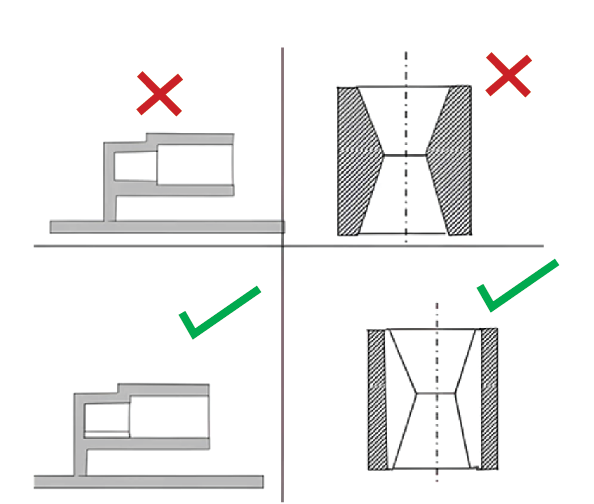
II. Gleichmäßige Wanddicke:
Sie sollte bei der Konstruktion über alle Abschnitte hinweg einheitlich sein, da Gleichmäßigkeit zu weniger Fertigungsproblemen führt. Wenn ein Teil dünne und dicke Wände hat, liegt das in der Regel an den unterschiedlichen Abkühlungsgeschwindigkeiten, die das Teil während des Formgebungsprozesses erfährt. Eine solche Abkühlung kann zu Verwerfungen führen. Dabei verbiegt oder verformt sich das Material oder es entstehen Dellen auf der Oberfläche, weil die dicken Teile mehr Zeit zum Abkühlen und Erstarren benötigen als die dünnen Teile.

2. Tiefgangswinkel
Entformungsschrägen sind leichte Erhöhungen an den Seiten eines Teils, damit es sich leicht aus der Form lösen lässt. Ohne Entformungsschrägen könnte sich das Kunststoffteil in der Form festsetzen, was sich nur schwer entfernen lässt, ohne die strukturelle Integrität des Teils und das Material der Form zu beeinträchtigen. Üblicherweise wird ein Entformungswinkel von 1 bis 3 Grad eingestellt, damit sich das Teil leicht aus der Form lösen lässt, ohne bestimmte Probleme zu verursachen.
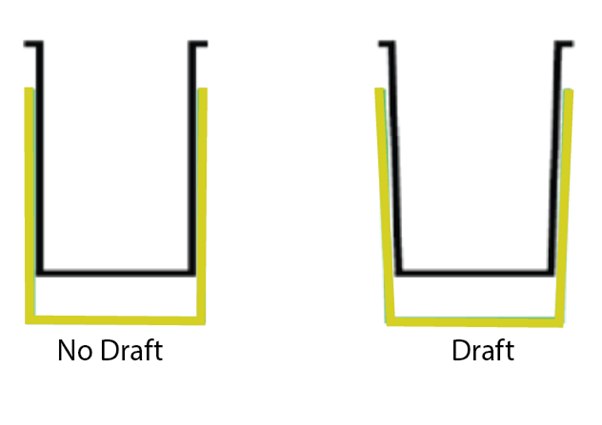
3. Toleranzen und Maßgenauigkeit
Toleranzen hingegen sind die zulässigen Grenzwerte für die Abweichung von den Abmessungen eines Teils. Diese Toleranzen müssen genau sein, damit das Teil gut passt und richtig funktioniert. Es gibt natürlich einige Einschränkungen und Anforderungen, die damit verbunden sind, z. B. dass engere Toleranzen wie kleine Abweichungen möglich sind. Sie sind jedoch kostspielig zu erreichen, da die Formen und die Qualitätskontrolle eine hohe Toleranz aufweisen. Im Gegensatz dazu sind die niedrigeren Toleranzwerte viel einfacher einzuhalten, aber gleichzeitig beeinflussen sie wahrscheinlich die Leistung oder die Interferenz des Teils.
4. Rippen und Bosse
I. Rippen
Rippen sind zusätzliche Verstärkungselemente, die in das Innere eines Teils eingearbeitet werden, um dessen Festigkeit und Steifigkeit zu erhöhen, dem Teil aber auch eine leichte zusätzliche Masse zu verleihen. Sie werden verwendet, um ein Verziehen des Teils zu verhindern, indem sie dem betreffenden Teil zusätzlichen Halt geben. Einfallstellen (das sind Dellen an der Stelle, an der die Rippe auf die Hauptwand trifft) sollten vermieden werden, indem die Rippen die Hälfte der Dicke der umgebenden Wände aufweisen. Die Rippen sind aus Edelstahl 304 gefertigt, um die Durchbiegung zu minimieren und die Belastung zu verringern.
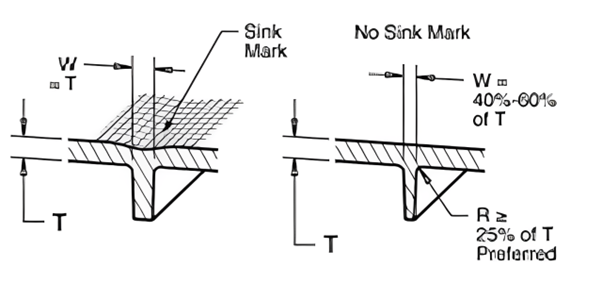
II. Chefs
Vorsprünge sind charakteristische erhabene Teile, die hauptsächlich als Verankerungspunkte für die Befestigung anderer Teile dienen. Sie müssen versteift werden, meist mit Rippen, damit sie mechanischen Belastungen standhalten, ohne zu brechen oder ihre Form zu verändern. Außerdem sollten sie in ausreichender Dicke gezogen werden, damit sie stabil genug sind, um dem Test der Zeit standzuhalten.
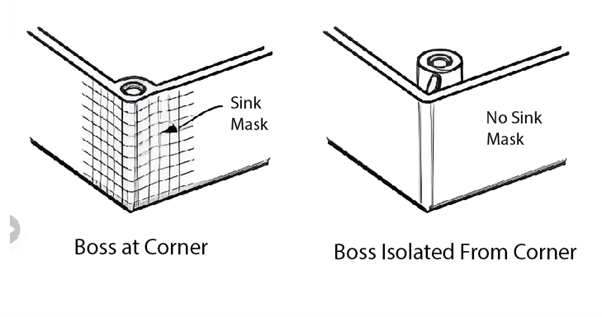
5. Gatter und Angüsse
I. Tore
Sie sind die Punkte, an denen der geschmolzene Kunststoff in die Form fließt oder eintritt. Die Platzierung und Gestaltung der Anschnitte ist ein weiterer wichtiger Punkt, der berücksichtigt werden muss, um sicherzustellen, dass die Form gefüllt wird, und vor allem, um Fehler zu reduzieren. Typische Anschnitte sind Randanschnitte, die an den Kanten des Teils positioniert werden, Stiftanschnitte, bei denen es sich um kleine, an einer bestimmten Stelle platzierte Anschnitte handelt, und Unterwasseranschnitte, die im Inneren des Teils positioniert werden. Ein geeignetes Design des Anschnitts gewährleistet, dass die Materialien gleichmäßig eingefüllt werden, um Verschwendung und die Entstehung von Fehlern zu vermeiden.
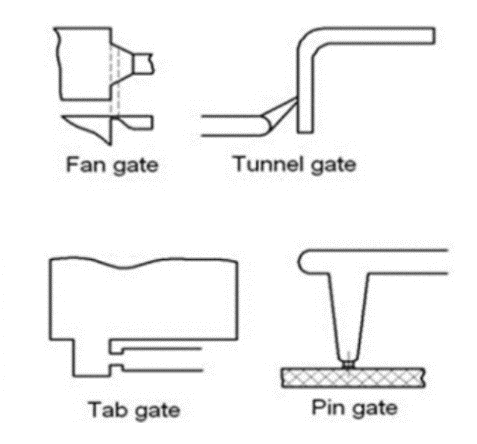
II. Gusskanäle
Der Anguss ist ein Angusssystem, durch das geschmolzener Kunststoff in den Formhohlraum geleitet wird. Der Anguss ist in der Regel dicker als andere Angüsse und wird oft separat geformt, damit er bei der Montage der Form leicht vom Rest der Form getrennt werden kann. Die Gestaltung eines einfachen und effizienten Angussmusters ermöglicht es, die Menge des verwendeten Abfallmaterials zu verringern und den Anguss leicht aus der Form zu entnehmen. Der Anguss sollte so gestaltet sein, dass er das Fließen des Kunststoffs begünstigt und die Menge des Kunststoffs, die nach dem Gießen abgeschnitten werden muss, möglichst gering ist.
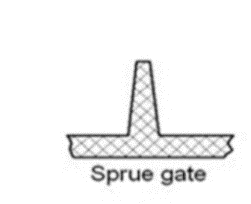
6. Auswurfsysteme
Funktion: Wenn das Teil nach dem Abkühlen erstarrt ist, werden die Auswerferstifte eingesetzt, um das Teil aus der Form zu werfen. Bei der Gestaltung der Auswerferstifte ist es wichtig, dass sie so um das Teil herum liegen, dass sie das Teil nicht beschädigen oder ihm sogar ein schlechtes Aussehen verleihen. Eine gute Positionierung der Auswerferstifte spielt eine wichtige Rolle für den einfachen und korrekten Ausstoß der Teile aus der Form.
| Entwurfsüberlegungen | Leitlinien/Wichtige Werte | Erläuterung |
| Komplexität | Einfachere Geometrien bevorzugt | Komplexe Konstruktionen erhöhen die Kosten und den Schwierigkeitsgrad der Form. |
| Gleichmäßige Wanddicke | 1,5 mm - 4 mm | Die gleichmäßige Dicke verhindert Verzug und Einfallstellen. |
| Tiefgangswinkel | 1° - 3° | Ermöglicht ein einfaches Auswerfen aus der Form. |
| Maßgenauigkeit | ±0,1 mm - ±0,5 mm | Abstimmung mit den Prozessfähigkeiten für kosteneffizientes Gießen. |
| Dicke der Rippen | 50% der Wandstärke | Es hilft, Einfallstellen zu vermeiden und verbessert die strukturelle Festigkeit. |
| Dicke des Aufsatzes | 60% - 80% mit Nennwanddicke | Gewährleistet mechanische Festigkeit und Belastbarkeit. |
| Standort des Tores | In der Nähe von dicken Abschnitten, weg von Sichtflächen | Gewährleistet eine ordnungsgemäße Befüllung und reduziert Fehler. |
| Anguss-Durchmesser | 1,5 mm - 6 mm | Sorgt für einen reibungslosen Fluss des geschmolzenen Kunststoffs. |
| Position des Auswerferstifts | Abseits von kosmetischen Oberflächen | Gewährleistet einen reibungslosen Teileauswurf ohne Oberflächenbeschädigung. |
7. Störungsanpassungen
Presspassungen werden dort eingesetzt, wo Bohrungen und Wellen so verbunden werden müssen, dass sie in der Lage sind, Drehmomente und andere Arten von Kräften effizient zu übertragen. Bei Presspassungen sollten Toleranzen und die Betriebstemperatur gut berücksichtigt werden, um eine zuverlässige Verbindung ohne großen Montageaufwand zu ermöglichen.
Der Grad des Übermaßes kann durch präzise mathematische Gleichungen bestimmt werden, die die Konstruktionsspannung, die Poissonzahl, den Elastizitätsmodul und die geometrischen Koeffizienten berücksichtigen. Die für die Presspassungen erforderliche Montagekraft wird ebenfalls durch diese Berechnungen abgeschätzt.
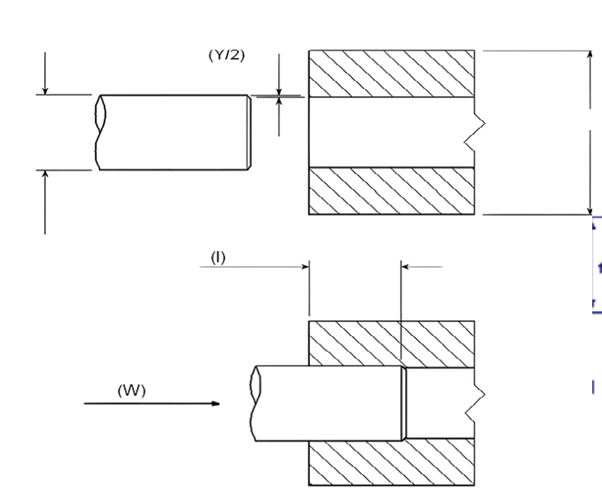
8. Verrundungen und abgerundete Ecken bei der Konstruktion von Kunststoffteilen
Dies führt zu Spannungskonzentrationen und Defekten an den Kunststoffteilen, wenn scharfe Ecken verwendet werden. Größere Werte der Verrundung, d. h. abgerundete Ecken, verringern die Spannungskonzentration und ermöglichen gleichzeitig ein freies und leichteres Fließen des Kunststoffs während des Formgebungsprozesses. Es ist von entscheidender Bedeutung, Konstruktionsprinzipien für den Eckenradius zu entwickeln, um die Probleme der gleichmäßigen Wandstärke und der Schrumpfung zu vermeiden.
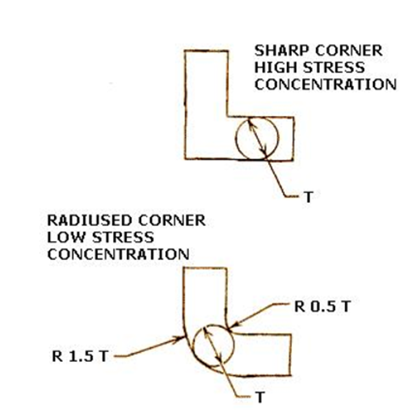
9. Löcher
I. Durchgehende Löcher
Löcher, die direkt durch die Dicke des Teils gehen, werden häufiger verwendet und sind einfacher zu erstellen als andere Arten von Löchern. Vom strukturellen Standpunkt aus sind sie bei der Konstruktion der Form am einfachsten zu kontrollieren. Sie können durch die Verwendung fester Kerne sowohl im gleitenden als auch im stehenden Teil der Form oder durch die Verwendung nur eines Kerns sowohl im gleitenden als auch im stehenden Teil der Form hergestellt werden. Im ersteren Fall bilden sich unter dem Einfluss der Kunststoffschmelze zwei Kragbalken mit kurzen Armen, die sich jedoch nur geringfügig verändern.
Letzterer bildet einen einfach gestützten Träger mit vernachlässigbarer Verformung. Um dies zu vermeiden, sollte der Durchmesser des einen Kerns etwas größer und der des anderen etwas kleiner sein als der des anderen, so dass alle Verbindungsflächen so glatt wie möglich sind.

II. Sacklöcher
Sacklöcher, d. h. Löcher, die nicht durch das Teil gebohrt werden, sind schwieriger zu formen. Sie werden im Allgemeinen mit einem freitragenden Balkenkern hergestellt, und der Kern neigt dazu, sich beim Aufprall des geschmolzenen Kunststoffs zu verbiegen, wodurch Löcher mit ungleichmäßiger Form entstehen. Sacklöcher sind Löcher, die abrupt enden, und im Allgemeinen sollte die Tiefe des Sacklochs nicht mehr als das Doppelte des Durchmessers des Lochs betragen.
Bei Sacklöchern mit einem Durchmesser von 1. sollte die Dicke 5 mm oder weniger betragen, während die Tiefe des Lochs den Durchmesser nicht überschreiten sollte. Die Dicke der Bodenwand des Sacklochs sollte mindestens ein Sechstel des Lochdurchmessers betragen, um eine Schrumpfung zu verhindern.
III. Seitliche Löcher
Seitliche Löcher werden durch seitliche Kerne hergestellt, was zu Kosten für die Form und die Wartung der Form führt, da die Länge der seitlichen Kerne ein Problem darstellen kann, da sie sich aufspalten können. Um diese Herausforderungen zu bewältigen, kann das Design effizienter gestaltet werden, um die derzeitigen Ineffizienzen und damit die Kosten zu korrigieren.
10. Schnappverbindungen bei der Konstruktion von Kunststoffteilen
Schnappverbindungen schonen die Tasche und die Umwelt, da keine weiteren Befestigungsmittel erforderlich sind. Es handelt sich um das Einhaken eines vorstehenden Teils über eine äußere Verlängerung eines anderen Teils, wobei die elastische Verformung der Teile die Bildung eines Verriegelungsschlüssels ermöglicht. Es gibt hauptsächlich drei Arten von Schnappverschlüssen, nämlich freitragende, ringförmige und kugelförmige.
Bei der Schnappverbindung gibt es zwei kritische Winkel: die Einzugsseite und die Eintrittsseite. Die Einzugsseite sollte normalerweise länger sein als die Dichtungsseite, um eine bessere Einrastleistung zu erzielen. Die zulässige Durchbiegung der Struktur kann durch spezifische Gleichungen für einen bestimmten Schnappverschluss unter Verwendung der Materialkonstanten und geometrischen Koeffizienten ermittelt werden.
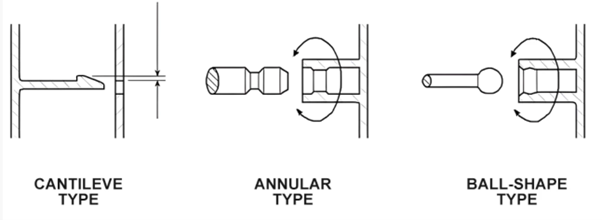
11. Oberflächenbeschaffenheit und Texturen
Die folgenden Methoden können uns helfen, eine effiziente Oberflächenbeschaffenheit und -struktur für das Endprodukt zu erreichen;
- Erreichen der gewünschten Ästhetik: Die Oberflächenbeschaffenheit eines Teils entscheidet nicht nur über sein Aussehen, sondern auch darüber, wie sich das Teil anfühlt. Der Designer legt die Textur oder das Finish je nach ästhetischen Anforderungen fest, z. B. matt oder glänzend.
- Einfluss der Textur auf die Formtrennung: Es zeigt sich, dass die Beschaffenheit der Oberflächenstruktur eine wichtige Rolle dabei spielt, wie leicht sich das Teil aus der Form lösen lässt. Komplexe Formen können bestimmte zusätzliche Herausforderungen mit sich bringen, die bei der Konstruktion nicht berücksichtigt werden sollten, um eine einfache Entformung zu ermöglichen.
- Techniken der Oberflächenveredelung: Eine zusätzliche Bearbeitung wie Polieren, Schleifen oder Auftragen einer Endbeschichtung ist möglich, um ein optimales Ergebnis zu erzielen.
12. Toleranzen und Maßhaltigkeit
Die folgenden Überlegungen werden also dazu beitragen, die Effizienz der Konstruktion von Kunststoffteilen zu erhöhen.
- Entwerfen für enge Toleranzen: Bauteile mit strengeren Toleranzen stellen eine große Herausforderung für den Formenbau dar, da der eigentliche Formgebungsprozess stärker kontrolliert werden muss. Einige wichtige Punkte sollten berücksichtigt werden, um die Unterschiede im Materialfluss und in der Kühlung zu berücksichtigen.
- Berücksichtigung von Materialschwund: Um die Materialschrumpfung zu kontrollieren, müssen die Konstrukteure die Größe des Formhohlraums etwas kleiner wählen. Die Verwendung dieses Formats trägt dazu bei, dass das endgültige Teil die erforderlichen Abmessungen einhält.
- Überlegungen zum Werkzeugbau: Das Werkzeug sollte daher maßgenau sein und gut gewartet werden, um die Maßhaltigkeit der Formteile zu verbessern.
13. Auswahl des Materials
Die Benutzer sollten daher sicherstellen, dass sie das geeignete Material auswählen, mit dem sie die erforderliche Leistung der Formteile erzielen können. Alle Thermoplaste, auch die amorphen und teilkristallinen, haben ihre eigenen Eigenschaften. Zu den Faktoren gehören die mechanische Festigkeit der zu verarbeitenden Materialien und ihre Kristallisation sowie ihre Hygroskopizität.
14. Mold Flow Analyse
Der Entwurfsteil umfasst auch die Analyse des Formflusses. Wir können sie also mit dem folgenden Verfahren optimieren;
- Die Bedeutung der Simulation des Materialflusses: Mit der Fließanalyse soll ermittelt werden, wie der geschmolzene Kunststoff voraussichtlich in der Form fließen wird. So können Bereiche mit Lufteinschlüssen, Bindenähten und ungleichmäßigem Fluss ermittelt werden.
- Identifizierung potenzieller Probleme: Es kann nachgewiesen werden, dass die Simulation einige Probleme vor der Herstellung identifizieren kann, die die Konstrukteure für den Teil der Formkonstruktion korrigieren können.
- Optimierung des Teiledesigns für den Formenfluss: Änderungen, die auf der Grundlage des Werkzeugflusses vorgenommen werden können, tragen zur Verbesserung der Teilequalität und zur Minimierung der Fehlerquote bei.
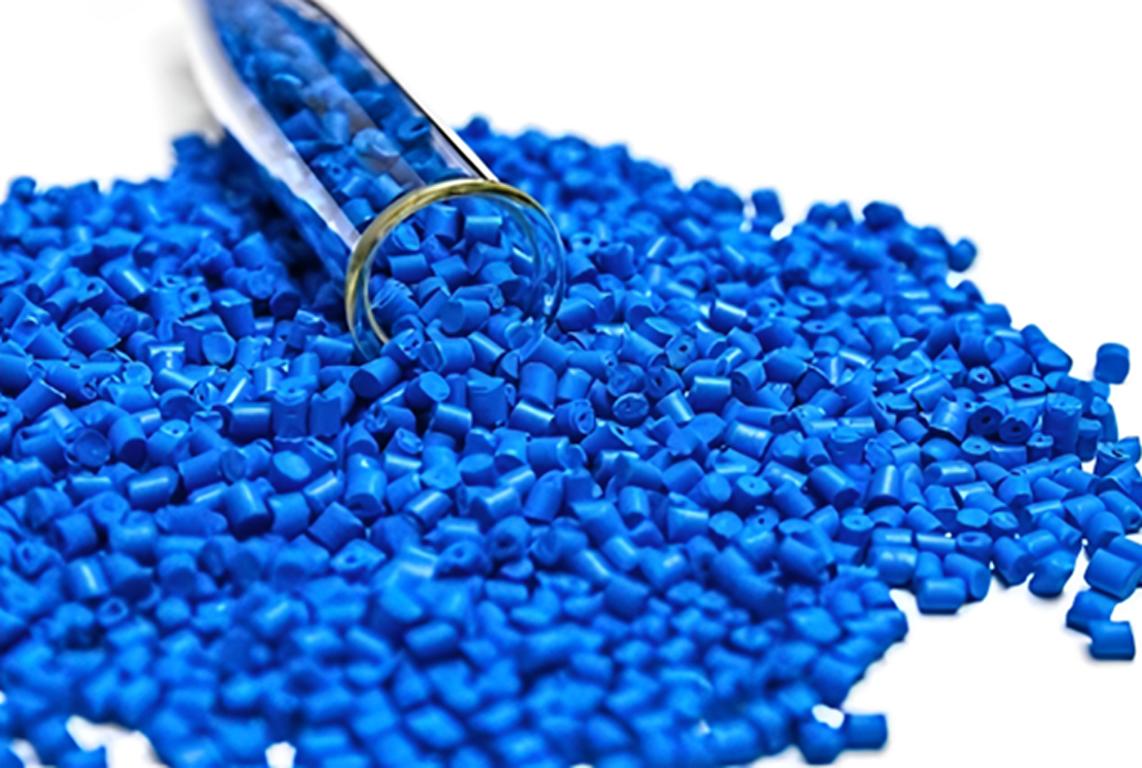
15. Prototyping und Tests
Hier sind also einige Prototyping- und Testtechniken, die wir für die Effektivität des Designteils verwenden können.
- Einsatz von Rapid-Prototyping-Techniken: Techniken wie das Rapid Prototyping helfen den Konstrukteuren, Prototypen des Ersatzteils zu bauen und das physische Teil zu testen und zu bewerten, bevor es für die Fertigung übernommen wird.
- Durchführung von physischen Tests: Prototypen, die einer Prüfung unterzogen werden und dieses Teil enthalten, ermöglichen eine Bewertung des Teils hinsichtlich seiner Leistung, Haltbarkeit und Fähigkeit, die vorgesehene Funktion zu erfüllen. Dies ist von zusätzlichem Wert, da es eine Vorstellung davon vermittelt, welche Verbesserungen an der Konstruktion vorgenommen werden können.
- Iteration von Entwürfen vor der endgültigen Produktion: Auf der Grundlage der Testergebnisse ist es möglich, die Konstruktion des Teils anzupassen und seine Probleme zu lösen sowie seine Leistung zu verbessern.
Häufige Designfehler und wie man sie vermeidet
Hier sind einige wichtige Fehler, die wir bei der Gestaltung von Kunststoffteilen vermeiden sollten.
- Schlechte Materialauswahl: Die Wahl eines ungeeigneten Materials beeinträchtigt die Leistung und die Herstellbarkeit des Teils. Es ist notwendig, die richtigen Materialien zu wählen, die den Anforderungen des Teils entsprechen.
- Entwurfswinkel ignorieren: Zum Beispiel können kleine Entformungswinkel zu Problemen beim Auswerfen der Teile und zum Verschleiß der Form führen. Stellen Sie sicher, dass die Entformungsschrägen im Layout enthalten sind.
- Überkomplizierung der Teilegeometrie: Solche Formen erschweren die Form und ihre Herstellung und erhöhen die Kosten für die Form. Reduzieren Sie die Komplexität der Entwürfe so weit wie möglich, um ihre Herstellbarkeit zu erhöhen.
- Unzureichende Wanddicke: Porosität, ungleichmäßige Dicke oder Schwankungen in der Wandstärke beeinträchtigen das Produkt und führen zu Problemen wie Verzug und Einfallstellen. Es ist wichtig, die Wandstärke des Teils konstant zu halten, um Schwankungen in der Wandstärke zu vermeiden.
Schlussfolgerung
Zusammenfassend lässt sich sagen, dass beim Entwurf eines Kunststoffteils für das Spritzgießen mehrere Faktoren berücksichtigt werden sollten, z. B. Lochtypen, Vorsprünge, Schnapp- oder Presspassungen und viele andere wie Toleranzen, erforderliche Materialien und Eckenradien. Wenn die Konstrukteure diese Grundsätze kennen, können sie Formteile entwickeln, die von guter Qualität, langlebig und kostengünstig herzustellen sind. Das Entwerfen von Konstruktionen entsprechend den Projektmerkmalen und Umgebungsbedingungen garantiert die besten Ergebnisse und Stabilität.
Häufig gestellte Fragen
Q1. Warum ist das Teiledesign beim Spritzgießen wichtig?
Es wird uns helfen, verfahrenstechnische und betriebliche Effizienz zu erreichen. Denn der Fertigungsentwurf umfasst Strategien, mit denen das Teil mit hoher Genauigkeit, weniger Fehlern und geringerem Materialeinsatz effektiv hergestellt werden kann.
Q2. Was sind Durchgangslöcher?
Durchgangslöcher sind Löcher, die durch ein ganzes Teil gehen. Sie sind relativ einfach zu formen und zu kontrollieren.
Q3. Was sind Sacklöcher?
Sacklochbohrungen gehen nicht durch ein Teil hindurch und können schwieriger zu formen sein, da die Bohrung verbogen und verformt werden kann.
Q4. Worauf beziehen sich die seitlichen Löcher beim Spritzgießen?
Die seitlichen Löcher werden mit seitlichen Kernen hergestellt, was die Komplexität der Form und damit die Kosten erhöhen kann. Kosten für Spritzgussform.
Q5. Wie sollten Chefs gestaltet sein?
Auch an den Anschlüssen sollten Hohlkehlen vorhanden sein und die Spritzguss-Wandstärke. So können sie dazu beitragen, der Belastung des Teils standzuhalten. Außerdem müssen die Vorsprünge in die Struktur des Teils einbezogen werden.
Q6. Was versteht man unter einer Schnappverbindung?
Bei der Schnappverbindung wird ein Teil elastisch verformt, um in ein anderes zu passen, so dass keine direkten mechanischen Verbindungselemente verwendet werden.
Q7. Wie berechnen wir den Eingriff, der vorgenommen werden sollte?
Die Interferenz wird durch die Bemessungsspannung, die Poissonzahl und die geometrischen Koeffizienten bestimmt.
Q8. Was sind Toleranzgrenzen beim Spritzgießen von Kunststoffen?
Die Toleranzgrenzen umfassen allgemeine, mittlere und hochpräzise Toleranzen, die die Qualität und die Preise der Produkte bestimmen. Spritzgießen Produkte.



Hinterlasse einen Kommentar
An der Diskussion beteiligen?Hinterlasse uns deinen Kommentar!